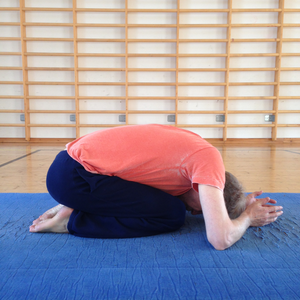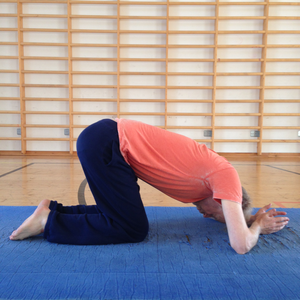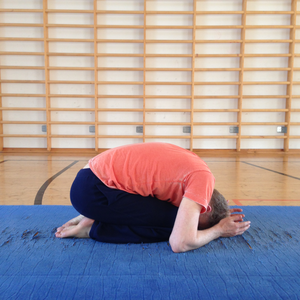I understand the functioning of the technique as follows.
The virtual space or ‘scene’ the exercise opens up for its performer is sustained by a compound of a necessarily limited number of psychophysical affinities between the human body and the gastropod body. These affinities or bodily tropes are easily recognised and named in the given example: a curved spine and back create the feeling of carrying a hard mantle or shell. The sliding movement and contact with the ground resembles the way the gastropods move. The mouth directed towards the ground imitates the way the animal nourishes itself. The movements and humidity of the lips and the tongue associate with the soft and slimy body of an invertebrate. The smacking sounds made by the mouth create an ambience similar to underwater acoustics. The sounds also work as signals to other gastropods. The movement of the fingers resembles that of the antennas. The movement of a gastropod is not directed by sight, it is guided partly by the search for imaginary nourishment, and partly by the movements of the whole gastropod colony.
From the biological or aesthetic perspective, the result may look like a caricature. Even though both of these perspectives may provide practitioners with useful information, the exercise is not based on it. The construction is sufficient to change the participants’ experience of their corporality so that it becomes unfamiliar, non-human and ´gastropodish’. The compound of chosen psychophysical tropes works like a mimetic attractor, which gathers mental images or memories of actual gastropods and their surroundings, the places and the moments the performer may have encountered in her life and reproduces in the performance. These individual sensory memory traces and the imaginings based on them reinforce and sustain the bodily composition, and vice-versa. The focus of the consciousness oscillates characteristically: at moments the performer feels like feeling like a gastropod, at moments she sees herself as seen as a gastropod. The consciousness of the actual empirical situation, of the performer´s I-perspective, does not disappear but accompanies the experience without compromising it. (Cf. Kirkkopelto 2015)
A question that is often raised in discussions about this practice concerns whether the resulting experience is “human” or “non-human” in nature. As I am currently inclined to think, the undecidability of the question is constitutive and revealing about the nature of embodied experiences in general: they are ambiguous by definition. As borderline experiences they are always “both-and” and “neither-nor”. As a practitioner, I have let the pond snail body touch my human body and, through that contact, I have reconstructed a virtual pond snail body of which it is impossible to say who is the “owner”: it resides somewhere between the radically different kinds of bodies.
Does a Tick Have a Body?
This quite lengthy analysis of the Other Spaces practice should make it easier to understand what happened in Tick Variations. Firstly, the experiment was largely based on experience gained through Other Spaces practices. These experiences have proved that, in a way, it is possible through embodied techniques to approach life-worlds and modes of being parallel to the human experience. Secondly, the Tick Variations take this experimentation a step further by radicalising the idea of a compound of corporeal tropes. In the Pond Snail exercise, for instance, the spatial and temporal coherence between the tropes was intimate and the body of the performer constituted their gathering centre, whereas in Tick Variations the tropes are produced by extra-corporeal technical means and their execution is dispersed in space and time.
I suggest in my additional methodological hypothesis that the dispersed spatio-temporal structure does not prevent the birth of the non-human experience. On the contrary, the gaps that Tick Variations imply stimulate the synthetic power of corporeal imagination, which aims to gather the dispersed elements into a meaningful whole: the tick body as a virtual intermediary entity, or the interface between a human and a tick.
In the experiment, this particular body was constructed through a series of three exercises, done in a row by three volunteers and with the help of three assistants. The experiment took place privately between the participants in an open-air space, in the back yard and the courtyard of the Sala del Camino on 15 June 2019, at noon. It was recorded on video. The video camera followed the event from above, through the open window of the exhibition hall on the first floor. Oral feedback from the volunteers was gathered in a series of interviews conducted immediately afterwards. The experiment was preceded by a one-hour introduction, in which the facilitator gave instructions to the participants and assistants, and all the phases were tested preliminarily in practice. On that same occasion, the participants read and signed the informed-consent form.
The course of the experiment is explained in detail on the next page.
REFERENCES:
Aloi, Giovanni (ed.). 2015. “Multispecies Intra-action”. Antennae: The Journal of Nature and Visual Culture. Issue 31.
Kirkkopelto, Esa. 2015. “The Ethics of the Gastropods. Analysis of a Trans-Human Practice”, Eurozine, 21 Oct 2015, https://www.eurozine.com/the-ethics-of-gastropods/
(accessed 27 Sept 2019)
METHODS
As I have argued (Kirkkopelto 2015, 2017), artistic research constitutes a methodologically creative practice. This is due to its phenomenotechnical nature: not only does it indicate a pathway to certain presumably existing phenomena, it also produces those phenomena by showing or performing them. One should not see a contradiction here. On the contrary, this fact shifts attention to the methodologically specific features of artistic research. Of these features, I emphasise the importance of one in particular: its take on reality is artistic from the very beginning. For an artist-researcher as for an artist the, domain of research is an inherently emergent dimension capable of appearing in ever new forms and showing ever new facets and aspects.
Artistic research can be also understood and practised as a means for studying the implicit artistic aspects of the non-artistic phenomena and reality. In that case, the focus is no longer on the production of art works or the improvement of artistic practices. Instead, one has to presume that there are artistic phenomena and modes of thinking that are independent of the existence of art works, artists and their particular modes of perceiving or experiencing. As an artist-researcher I am interested in questioning and studying the existence of these artistic ingredients of reality, which in the last resort may also help to shed light on the provenance of the arts in their various and historical forms.
As I see it, a step towards this kind of reasoning has already been taken in that artists nowadays discuss and are interested in interspecies relations, or aim at creating artistic interfaces between human experience and non-human processes (see for instance Aloi 2015). From the wider perspective of academic research, this tendency implies an obvious dilemma. On the one hand, if we continue to lean uniquely on the scientific evidence arising from biology, psychology or cognitive science, for instance, these kinds of artistic endeavour risk sounding and looking, if not nonsensical, at least highly speculative. On the other hand, giving artistic agency to something non-human implies the need for radical changes in current epistemological and aesthetic paradigms. Resolving this dilemma constitutes a challenge for artistic research, which tends to serve as an intermediary between the arts and other modes of knowledge formation.
In the case of “Tick Variations”, the artistic practice or medium that changes into a research practice or medium (Kirkkopelto 2017) derives from the bodily techniques I have been developing with the Other Spaces group. The realm I study concerns the embodied aspects of experience: artistic bodily techniques are applied to study the corporeal aspects of interspecies relations and their epistemic conditions.
Problematic vs. Established Bodily Techniques
On the level of scientific discussion, “bodily techniques” or “techniques of the body” (Mauss 1934) concern emergent objects the genealogy and historical reality of which are dependent on actual practice. A bodily technique may have been recently invented, in which case it constitutes a problem and a challenge for the community in which it has been introduced. It may raise various questions, such as: Can we rely on this technique? Is it safe? Is it just a joke? Is it genuine or just copied or stolen from some other context? Does it “work”? In which conditions does it work? For whom is it convenient? Do I like it? Am I ready and willing to continue to practise it? It is problematic as long as it continues to raise questions of this type.
A bodily technique becomes established gradually through social embodiment, which tends to be based on an accumulation of quite heterogeneous evidence: a technique is widely practised, its practice is culturally unquestioned, it is fashionable or popular, there is scientific evidence and/or common unanimity concerning its benefits and efficiency in relation to the desired goals, it pleases personally and corresponds to one´s needs and beliefs, for example. One could consider such techniques cultural constructs that change the way one behaves, perceives and experiences them, both as a user and as an observer.
The same kind of dynamics are evident in the experimental and artistic bodily techniques of the Other Spaces group: a practice that was initially questionable and doubtful has little by little, after 16 years of practice, become more and more firmly established. At this point in time, one can agree that the Other Spaces exercises “work” without promoting them. They are not reducible to other techniques: they are safe; they produce repeatable, shareable and mutually comparable experiences among their practitioners, and the making of them is desirable and enjoyable for many. This does not deny the fact that the epistemic and ontological nature of that technique, as is the case with all artistic bodily techniques, remains enigmatic. Uncontestably, it is possible for a human being to adopt it, but how it is possible remains unclear and requires investigation that should not ignore its artistic nature.
The technique of a non-human practice
The easiest and clearest way to explain what happens in the exercises is to take an example. For that purpose, I will return to a case that I have demonstrated on many occasions, namely that of a “Pond Snail”. In the exercise, the performer gradually approaches the way of experiencing of a small invertebrate animal with a spiral-shaped shell (family: lymnaedae), which lives at the bottom of shallow freshwaters – rivers, lakes and ponds – and nourishes itself with vegetal material. The exercise is done collectively. The human gastropods move around slowly, communicating with each other via their antennas.
Below, a series of images in which the author demonstrates the way the human pond snail moves.


